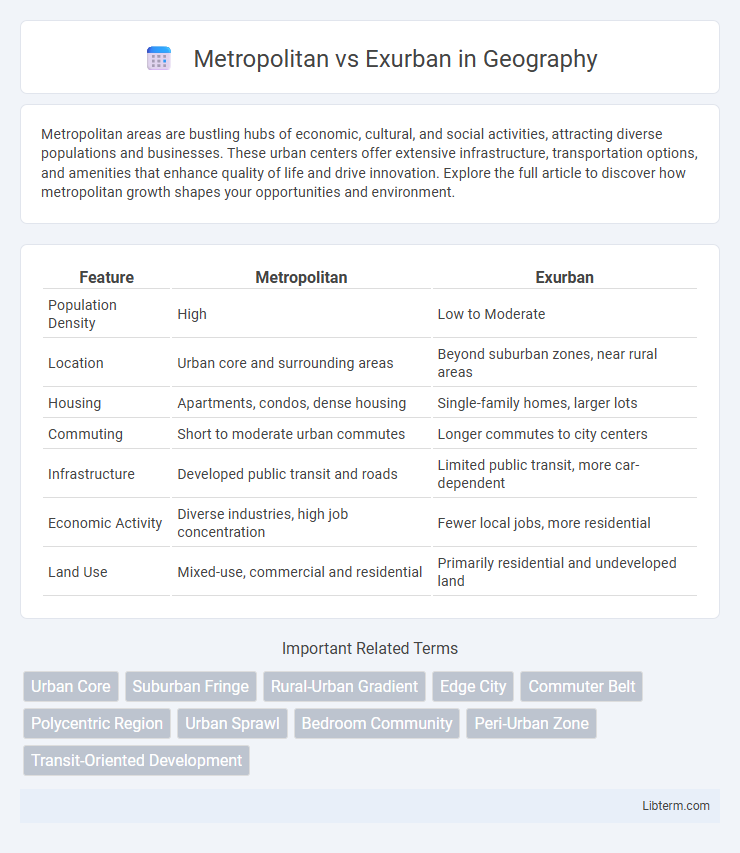Metropolitan areas are bustling hubs of economic, cultural, and social activities, attracting diverse populations and businesses. These urban centers offer extensive infrastructure, transportation options, and amenities that enhance quality of life and drive innovation. Explore the full article to discover how metropolitan growth shapes your opportunities and environment.
Table of Comparison
| Feature | Metropolitan | Exurban |
|---|---|---|
| Population Density | High | Low to Moderate |
| Location | Urban core and surrounding areas | Beyond suburban zones, near rural areas |
| Housing | Apartments, condos, dense housing | Single-family homes, larger lots |
| Commuting | Short to moderate urban commutes | Longer commutes to city centers |
| Infrastructure | Developed public transit and roads | Limited public transit, more car-dependent |
| Economic Activity | Diverse industries, high job concentration | Fewer local jobs, more residential |
| Land Use | Mixed-use, commercial and residential | Primarily residential and undeveloped land |
Definition of Metropolitan and Exurban Areas
Metropolitan areas are densely populated urban regions characterized by significant economic activity, infrastructure, and connectivity, often encompassing a major city and its surrounding suburbs. Exurban areas lie beyond the metropolitan perimeter, featuring lower population density, more rural landscapes, and residential developments that attract commuters seeking a balance between urban accessibility and open space. These distinctions highlight the varying degrees of urbanization and land use intensity between metropolitan cores and their exurban outskirts.
Key Demographic Differences
Metropolitan areas typically feature dense populations with diverse age groups, higher median incomes, and significant cultural and economic activity concentration, attracting young professionals and families. Exurban regions experience lower population densities, often characterized by older demographics, larger household sizes, and increased reliance on private transportation due to limited public transit options. Educational attainment and employment sectors also differ, with metropolitan residents more frequently engaged in service and technology industries, while exurban populations may lean toward agriculture, manufacturing, or commuting to urban job centers.
Economic Activities and Employment Trends
Metropolitan areas exhibit diverse economic activities driven by finance, technology, healthcare, and professional services, leading to higher employment rates and wage levels. Exurban regions primarily rely on agriculture, manufacturing, and resource-based industries, often experiencing slower employment growth and limited sector diversity. Urban-centric economic opportunities fuel robust job markets in metropolitan zones, while exurban employment trends reflect regional specialization and commuting patterns.
Housing and Real Estate Market Comparison
Metropolitan areas feature dense housing markets with higher property values driven by demand for proximity to urban jobs, amenities, and public transit, resulting in predominantly multi-family units and high-rise apartments. Exurban regions offer more affordable real estate options with larger single-family homes on spacious lots, attracting buyers seeking lower prices and quieter environments outside city cores. The metropolitan market exhibits faster appreciation rates and greater competition, whereas exurban housing shows slower growth but higher potential for long-term suburban expansion.
Transportation and Commute Patterns
Metropolitan areas feature extensive public transportation networks, including subways, buses, and commuter trains that facilitate shorter, multimodal commutes for residents. Exurban regions rely heavily on personal vehicles due to limited public transit options, resulting in longer commute times and higher traffic congestion during peak hours. The increased dependence on cars in exurban areas contributes to greater environmental impact compared to metropolitan zones with more efficient transit systems.
Infrastructure and Public Services
Metropolitan areas typically feature well-developed infrastructure with extensive public transportation systems, including subways, buses, and commuter trains, facilitating efficient urban mobility. In contrast, exurban regions often lack comprehensive public transit, relying heavily on personal vehicles due to limited road networks and fewer transportation options. Public services such as healthcare, education, and emergency response are generally more accessible and advanced in metropolitan centers compared to the sparse, sometimes under-resourced facilities found in exurban communities.
Quality of Life Considerations
Metropolitan areas offer diverse cultural amenities, advanced healthcare facilities, and extensive public transportation, enhancing convenience and access. Exurban regions provide more spacious living environments, lower pollution levels, and a stronger connection to nature, which contributes to reduced stress and improved mental well-being. Quality of life considerations often depend on individual preferences for lifestyle pace, community engagement, and proximity to urban services.
Social and Cultural Opportunities
Metropolitan areas offer a rich diversity of social and cultural opportunities, including theaters, museums, music venues, and a variety of dining experiences that cater to diverse populations. Exurban regions typically provide limited access to such amenities, emphasizing more community-centered events and outdoor recreational activities. Residents in metropolitan settings benefit from greater exposure to multicultural events and networking opportunities that foster professional and social growth.
Environmental Impact and Sustainability
Metropolitan areas generate higher pollution levels and urban heat islands due to dense infrastructure and increased vehicle emissions, posing significant environmental challenges. Exurban regions, characterized by low-density development and greater reliance on automobiles, lead to habitat fragmentation and increased carbon footprints despite lower direct emissions. Sustainable planning efforts must emphasize green infrastructure, efficient public transit in metropolitan zones, and conservation practices to mitigate ecological degradation in exurban sprawl.
Future Growth and Urbanization Trends
Metropolitan areas are expected to experience sustained population growth driven by economic opportunities, infrastructure development, and increasing demand for housing, resulting in higher urban density and expanded public transit systems. Exurban regions, characterized by lower density and more affordable living, are projected to attract residents seeking suburban benefits with more space, contributing to sprawl and increased demand for road infrastructure. Urbanization trends indicate a shift toward integrated metropolitan planning to balance growth with sustainability, while exurban expansion challenges policymakers to manage resource allocation and environmental impact effectively.
Metropolitan Infographic

 libterm.com
libterm.com